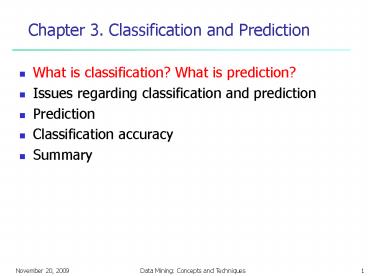Chapter 3' Classification and Prediction - PowerPoint PPT Presentation
1 / 10
Title:
Chapter 3' Classification and Prediction
Description:
predicts categorical class labels (discrete or nominal) ... is represented as classification rules, decision trees, or mathematical formulae ... – PowerPoint PPT presentation
Number of Views:105
Avg rating:3.0/5.0
Title: Chapter 3' Classification and Prediction
1
Chapter 3. Classification and Prediction
- What is classification? What is prediction?
- Issues regarding classification and prediction
- Prediction
- Classification accuracy
- Summary
2
Classification vs. Prediction
- Classification
- predicts categorical class labels (discrete or
nominal) - classifies data (constructs a model) based on the
training set and the values (class labels) in a
classifying attribute and uses it in classifying
new data - Prediction
- models continuous-valued functions, i.e.,
predicts unknown or missing values - Typical Applications
- credit approval
- target marketing
- medical diagnosis
- treatment effectiveness analysis
3
ClassificationA Two-Step Process
- Model construction describing a set of
predetermined classes - Each tuple/sample is assumed to belong to a
predefined class, as determined by the class
label attribute - The set of tuples used for model construction is
training set - The model is represented as classification rules,
decision trees, or mathematical formulae - Model usage for classifying future or unknown
objects - Estimate accuracy of the model
- The known label of test sample is compared with
the classified result from the model - Accuracy rate is the percentage of test set
samples that are correctly classified by the
model - Test set is independent of training set,
otherwise over-fitting will occur - If the accuracy is acceptable, use the model to
classify data tuples whose class labels are not
known
4
Classification Process (1) Model Construction
Classification Algorithms
IF rank professor OR years gt 6 THEN tenured
yes
5
Classification Process (2) Use the Model in
Prediction
(Jeff, Professor, 4)
Tenured?
6
Supervised vs. Unsupervised Learning
- Supervised learning (classification)
- Supervision The training data (observations,
measurements, etc.) are accompanied by labels
indicating the class of the observations - New data is classified based on the training set
- Unsupervised learning (clustering)
- The class labels of training data is unknown
- Given a set of measurements, observations, etc.
with the aim of establishing the existence of
classes or clusters in the data
7
What Is Prediction?
- Prediction is similar to classification
- First, construct a model
- Second, use model to predict unknown value
- Major method for prediction is regression
- Linear and multiple regression
- Non-linear regression
- Prediction is different from classification
- Classification refers to predict categorical
class label - Prediction models continuous-valued functions
8
Predictive Modeling in Databases
- Predictive modeling Predict data values or
construct generalized linear models based on
the database data. - One can only predict value ranges or category
distributions - Method outline
- Minimal generalization
- Attribute relevance analysis
- Generalized linear model construction
- Prediction
- Determine the major factors which influence the
prediction - Data relevance analysis uncertainty measurement,
entropy analysis, expert judgement, etc. - Multi-level prediction drill-down and roll-up
analysis
9
Classification Accuracy Estimating Error Rates
- Partition Training-and-testing
- use two independent data sets, e.g., training set
(2/3), test set(1/3) - used for data set with large number of samples
- Cross-validation
- divide the data set into k subsamples
- use k-1 subsamples as training data and one
sub-sample as test datak-fold cross-validation - for data set with moderate size
- Bootstrapping (leave-one-out)
- for small size data
10
Summary
- Classification is an extensively studied problem
(mainly in statistics, machine learning neural
networks) - Classification is probably one of the most widely
used data mining techniques with a lot of
extensions - Scalability is still an important issue for
database applications thus combining
classification with database techniques should be
a promising topic - Research directions classification of
non-relational data, e.g., text, spatial,
multimedia, etc..































